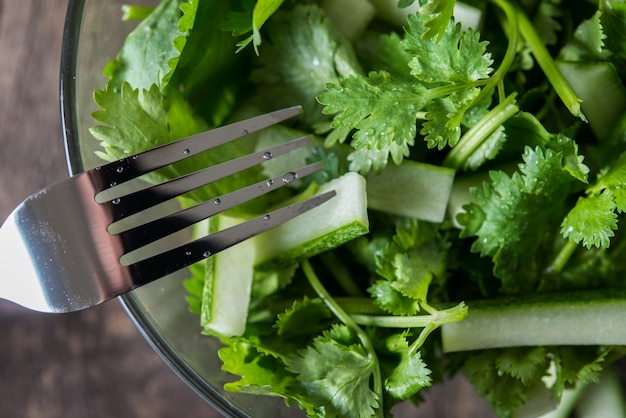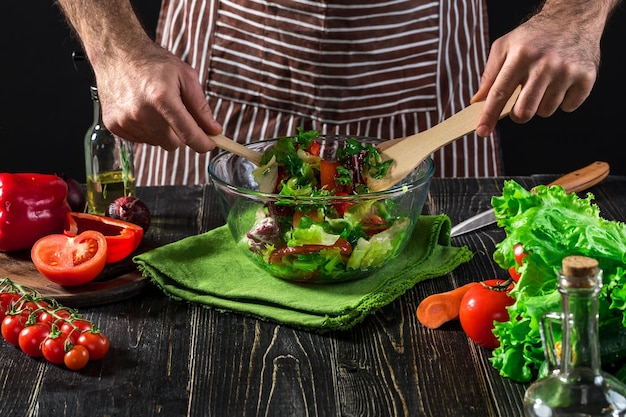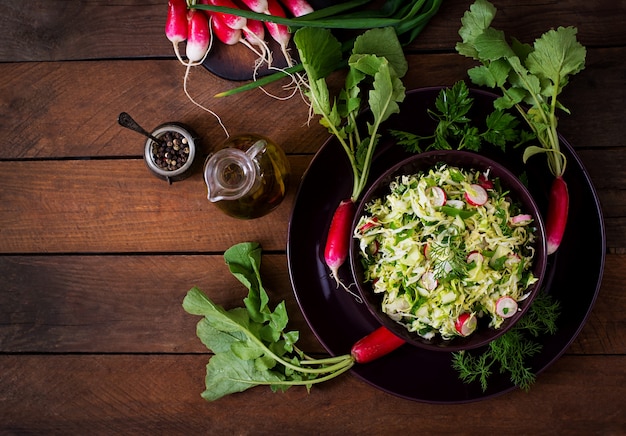Let's talk collard greens, those big, leafy greens that are synonymous with Southern cooking. I've loved them since I was a kid. My grandma would make this massive pot of collard greens, simmering away all day long, and the aroma would fill the house. It was pure comfort. Now, I'm not a culinary expert, but over the years, I've learned a thing or two about cooking these delicious greens. It's not rocket science, I promise. Today, I'm going to share all my tips and tricks to help you make the ultimate Southern-style collard greens, just like grandma used to make.
(Part 1) Choosing the Right Collard Greens

The first step to perfect collard greens is choosing the right ones. It's all about quality, you see. Fresh is always best, ideally from a local farmer's market or a reputable grocery store. Look for vibrant, dark green leaves that are firm and crisp, with no signs of wilting or yellowing. If the leaves are too big, you might need to chop them up a bit, but that's no big deal.
The Importance of Freshness
Now, I'm not saying you can't use frozen collard greens, but fresh is definitely the way to go. fresh greens have that vibrant green colour and crisp texture that just can't be replicated with frozen greens. Plus, they have a deeper, more earthy flavour that just sings. It's a whole different experience!
Types of Collard Greens
There are a few different types of collard greens, but the most common one you'll find is the 'Georgia' variety. They have broad leaves and a slightly peppery flavour. Another popular choice is 'Vates', which are known for their tender leaves and mild flavour. It really comes down to personal preference, but I tend to stick with the 'Georgia' ones - they're just a classic!
(Part 2) Preparing the Collard Greens

Okay, so you've got your lovely fresh greens. Now it's time to prep them. Don't worry, it's not complicated, just a bit of chopping and cleaning.
Washing the Greens
Start by washing the greens thoroughly. You want to get rid of any dirt, grit, or pesky bugs. I usually give them a good rinse in a colander under running water, then I'll dunk them in a bowl of cold water, swish them around, and drain them again. You can repeat this process a couple of times if you're feeling extra thorough. It's all about getting those greens nice and clean.
Chopping the Greens
Next up, you'll want to chop those greens. You can cut them into smaller pieces for easier cooking. I usually chop them into about 1-inch wide strips. Some people prefer to chop them even smaller, it really depends on your personal preference. The key is to make the greens a manageable size so they cook evenly. It's also a good idea to remove the tough stems, you know, the thicker white bits. Just slice them off and toss them aside.
(Part 3) The Art of cooking collard greens

Now we're getting to the good stuff - actually cooking the greens. This is where the real magic happens. There are a few different methods you can use, but I'm going to focus on the traditional Southern way, which involves simmering them in a pot with water and a whole lot of flavour.
The Basic Method
First, grab a large pot, preferably a dutch oven, and fill it with about half an inch of water. Bring the water to a boil over high heat, then add your chopped collard greens. Reduce the heat to a simmer, cover the pot with a lid, and cook for about 2-3 hours, or until the greens are tender and wilted. This is the basic method, but remember, it's just a starting point. We're about to add some flavour!
Adding Flavor
Now, the fun part - flavouring the greens. I've got my go-to recipe, but feel free to experiment and add your own personal touches. A common method involves adding a piece of smoked ham hock or bacon to the pot. The fat from the meat will melt into the greens, adding a rich, smoky flavour. Alternatively, you can use a combination of salt pork, smoked turkey neck, or even a ham bone. For a vegetarian option, vegetable broth or water with a generous amount of salt and pepper will do the trick.
(Part 4) The Importance of Patience
Don't be tempted to rush the cooking process. Collard greens take time. It's all about letting them simmer slowly and develop that rich, deep flavour. Remember, the longer you cook them, the more tender they become. Now, I know you might be tempted to peek inside the pot every now and then, but try to resist. You don't want to let all that precious steam escape! Just trust the process, my friend. It's worth the wait, I promise.
(Part 5) Enhancing the Flavour
Once your collard greens are simmering away, there are a few other things you can add to enhance the flavour. It's all about creating a symphony of tastes, you know?
Essential Spices
A pinch of garlic powder, onion powder, black pepper, and red pepper flakes are my must-haves. They really bring out the flavour of the greens and create a nice warmth. I also like to add a bay leaf or two, which adds a subtle, earthy note. And for a touch of sweetness, a little bit of brown sugar or molasses can do wonders. Just be careful not to overdo it - you don't want to make the greens too sweet!
Vinegar for Extra Zing
Another trick I've learned over the years is to add a splash of vinegar towards the end of cooking. This adds a lovely tanginess that cuts through the richness of the greens. Apple cider vinegar or white vinegar both work beautifully, but I prefer apple cider vinegar for its milder taste. Again, just a small amount is all you need, don't go overboard!
(Part 6) The Finishing Touches
Alright, so your collard greens have been simmering for a couple of hours, they're nice and tender, and they're bursting with flavour. Now it's time to give them that final touch.
Salt and Pepper to Taste
Start by tasting the greens and adjusting the seasoning. Add more salt and pepper if needed. Don't be shy, taste it as you go. Remember, you can always add more, but you can't take it away!
Garnish with Love
Finally, it's time to add those finishing touches. I like to garnish my collard greens with a sprinkle of fresh chopped parsley or chives. It adds a vibrant colour and a fresh, herbaceous aroma. A dash of hot sauce is a must for me, but that's totally up to you.
(Part 7) Serving Collard Greens
You've put in the effort, now it's time to enjoy the fruits of your labour. There's something really satisfying about serving up a big bowl of these greens. It's a classic Southern dish that's perfect for any occasion.
A side dish Delight
Collard greens are typically served as a side dish. They're often paired with other Southern staples, such as cornbread, fried chicken, or barbecue. They also make a delicious accompaniment to any type of roasted meat or fish. I personally love them with a side of mashed potatoes and a simple salad.
Get Creative with Your Serving
Don't be afraid to get creative with your serving! You can add a dollop of sour cream or a sprinkle of crumbled bacon for extra richness. And if you're feeling adventurous, try adding some chopped tomatoes, onions, or even a handful of cooked black-eyed peas. The possibilities are endless!
(Part 8) Tips for Storing and Reheating
Let's be honest, sometimes you might end up with more collard greens than you can eat in one sitting. That's okay, they keep well in the fridge and can be easily reheated. Let's talk about how to do it properly.
Storing
Once your collard greens have cooled down, store them in an airtight container in the refrigerator. They'll stay fresh for up to 3-4 days. Just make sure you give them a good stir before serving to evenly distribute the flavour and moisture.
Reheating
To reheat collard greens, simply place them in a saucepan or microwave-safe dish and heat them through. I prefer to reheat them on the stovetop, as it allows the flavours to meld even further. You can add a little bit of water or broth if they seem dry, just be careful not to overcook them. A few minutes on low heat is usually enough to warm them up nicely.
(Part 9) The Science Behind Collard Greens
Beyond their deliciousness, collard greens are a powerhouse of nutrients. They're packed with vitamins A, C, and K, as well as minerals like calcium, iron, and potassium. They're also low in calories and fat, making them a healthy choice. Adding them to your diet can help to improve your overall health. The dark green colour comes from chlorophyll, which has been shown to have antioxidant and anti-inflammatory properties. So you're not only enjoying a delicious meal but also giving your body some much-needed nutrients.
(Part 10) FAQs
Now, let's tackle some frequently asked questions about collard greens. You've got questions, I've got answers!
What is the best way to get rid of the bitterness in collard greens?
The key to reducing bitterness is to cook them long enough. That's why I recommend simmering them for at least 2-3 hours. This allows the greens to soften and release their bitterness. Adding a little bit of sugar or molasses can also help to balance out the bitterness. You can also try blanching the greens in boiling water for a few minutes before adding them to the pot. This helps to break down the tough fibers and reduce the bitterness.
Can I use collard greens in other dishes?
Absolutely! Collard greens can be used in a variety of dishes beyond the traditional Southern side dish. Try using them in soups, stews, or stir-fries. They also make a great filling for wraps and burritos. Get creative and experiment with different flavours!
What are the nutritional benefits of collard greens?
Collard greens are packed with nutrients! They're a good source of vitamins A, C, and K, as well as minerals like calcium, iron, and potassium. They're also low in calories and fat, making them a healthy choice. Adding them to your diet can help to improve your overall health.
How do I know if my collard greens are done?
You'll know your collard greens are done when they're nice and tender, and they've wilted down significantly. They should easily break apart with a fork and have a deep, rich colour. If they're still tough and crunchy, they need to cook a little longer.
Is there a substitute for ham hock or bacon?
Yes! If you're vegetarian or simply don't want to use pork products, you can use vegetable broth or water with a generous amount of salt and pepper to flavour your collard greens. You can also add a few tablespoons of olive oil or coconut oil for a rich, fatty flavour. And, of course, feel free to get creative and add other herbs and spices to taste.
(Part 11) The History of Collard Greens
The story of collard greens is fascinating. It's believed that they originated in the Mediterranean region and were brought to the Americas by European settlers. However, they truly flourished in the South, where the warm climate and rich soil provided ideal growing conditions. Collard greens became a staple food for African Americans during slavery, as they were readily available and could be grown even in challenging conditions. The tradition of cooking them with meat, often ham hocks, developed during this time.
Collard greens became deeply ingrained in Southern culture and have remained a cherished symbol of the region's culinary heritage ever since. It's a dish that brings people together, reminding us of family, tradition, and the importance of sharing a meal.
(Part 12) Final Thoughts
There you have it, my guide to the ultimate Southern-style collard greens. It's all about finding what works for you, experimenting with different flavours, and having fun in the kitchen. Remember, these greens are a symbol of Southern hospitality and comfort food. So next time you're craving a taste of the South, whip up a pot of collard greens and enjoy the delicious flavours. It's a recipe that's been passed down for generations, and I hope you'll make it your own.
From choosing the right greens to adding those finishing touches, I hope you feel confident and inspired to try your hand at making this Southern staple. After all, there's nothing quite like a big bowl of collard greens, cooked with love and bursting with flavour, to warm the soul.
Everyone is watching

Corn on the Cob: The Ultimate Guide to Perfectly Cooked Ears
Healthy MealsAh, corn on the cob. Just the name evokes images of sunny days, barbecues, and that sweet, juicy flavour that ...

Perfect Pork Roast Oven Cooking Time: A Guide to Delicious Results
Healthy MealsThere's something truly satisfying about a perfectly roasted pork. The aroma alone is enough to make your mout...

Ham Cooking Time: How Long to Bake, Smoke, or Boil a Delicious Ham
Healthy MealsAh, ham. It's a classic, isn't it? A real crowd-pleaser, especially around holidays. And when done right, it'...

Scallops: The Ultimate Guide to Perfect Cooking
Healthy MealsAh, scallops. Those delicate, sweet, and utterly delicious morsels of the sea. They hold a special place in my...

Spaghetti Squash: The Ultimate Guide to Cooking and Serving
Healthy MealsRemember that time you saw spaghetti squash at the supermarket, looking all bumpy and strange, and thought, "W...
